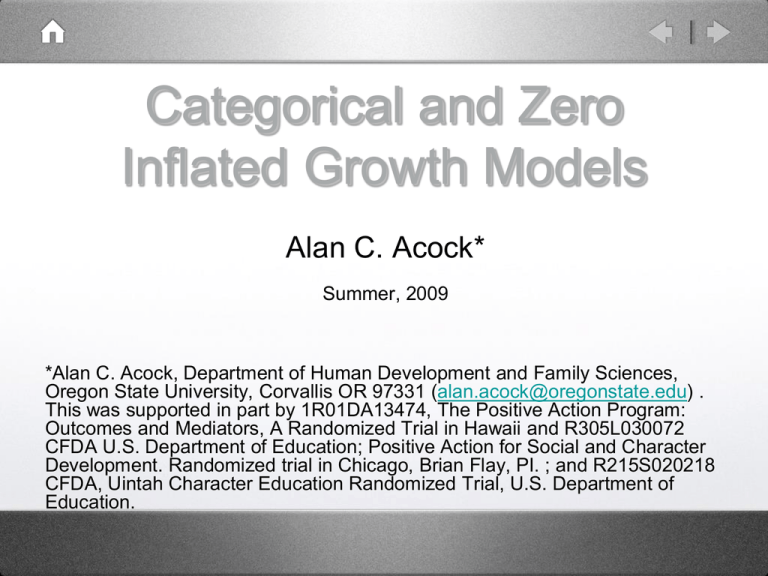
Categorical and Zero
Inflated Growth Models
Alan C. Acock*
Summer, 2009
*Alan C. Acock, Department of Human Development and Family Sciences,
Oregon State University, Corvallis OR 97331 (alan.acock@oregonstate.edu) .
This was supported in part by 1R01DA13474, The Positive Action Program:
Outcomes and Mediators, A Randomized Trial in Hawaii and R305L030072
CFDA U.S. Department of Education; Positive Action for Social and Character
Development. Randomized trial in Chicago, Brian Flay, PI. ; and R215S020218
CFDA, Uintah Character Education Randomized Trial, U.S. Department of
Education.
Topics to Be Covered
• Predicting Rare Events
• Binary Growth Curves
• Count Growth curves
• Zero-Inflated Poisson Growth Curves
• Latent Class Zero-Inflated Poisson Models
• A detailed presentation of the ideas is available at
www.oregonstate.edu/~acock/growth
Alan C. Acock
2
Predicting Rare Events
• Physical conflict in romantic
relationships
• Frequency of depressive
symptoms
• Frequency of Parent-Child Conflict
• Frequency of risky sex last month
Alan C. Acock
3
Poisson with too many zeros
Binary: Does Behavior Occur
• Structural zeros—behavior is not in
behavioral repertoire
• Do not smoke marijuana Didn’t smoke last
month
• Chance zeros—Behavior part of
repertoire, just not last month
• No fight with spouse last week, but . . .
Alan C. Acock
5
Count Component
• Two-part model
• Equation for zero vs. not zero
• Equation for those not zero. Zeros are
missing values
• Zero-inflated model—includes both
those who are structural zeros and chance
zeros
Alan C. Acock
6
Trajectory of the Probability of Behavior
Alan C. Acock
7
Trajectory of the Count of behavior
Occurring?
Alan C. Acock
8
Why Aren’t Both Lines Straight?
• We use a linear model of the growth curve
• We predict the log of the expected
count
• We predict log odds for the binary
component
Alan C. Acock
9
Why Aren’t Both Lines Straight?
• For the count we are predicting
• Expected = ln( ) = + Ti
• Ti (0, 1, 2, . . .) is the time period
• is the intercept or initial value
• is the slope or rate of growth
Alan C. Acock
10
Why Aren’t Both Lines Straight?
• Expected log odds or expected
log count, are linear
• Expected probability or expected
count, are not linear
Time Invariant Covariates
Time invariant covariates are
constants over the duration of study
• May influence growth in the binary
and count components
• May influence initial level of binary
and count components
• Different effects a major focus
Alan C. Acock
11
Time Invariant Covariates
• Mother’s education might
influence likelihood of being
structurally zero
• Mother’s education might be
negatively related to the rate of
growth
Alan C. Acock
12
Time Varying Covariates
Time Varying Covariates—variables
that can change across waves
• Peer pressure may increase each
year between 12 and 18
• The peer pressure each wave can
directly influence drug usage that
year
Alan C. Acock
13
Estimating a Binary
Growth Curve
• Brian Flay has a study in Hawaii evaluating
Example
Binary
Component
the Positiveof
Action
Program
in Grades 1 4
• Key outcome—reducing negative
responses to behaviors that Positive Action
promotes
• Gender is a time invariant covariate—boys
higher initially but to have just as strong a
negative slope
• Level of implementation is a time varying
covariate —the nearly 200 classrooms vary. A
Latent Profile Analysis
produced two classes on 15
Alan C. Acock
implementation
Binary Model
Alan C. Acock
16
Predicting a Threshold
Thresholds
Alan C. Acock
17
Binary Growth Curve
Program—Part 1
Title: workshop binary growth.inp
Data: File is workshop_growth.dat ;
Variables:
Names are
idnum s1flbadc s2flbadc s3flbadc s4flbadc male s1flbadd
s2flbadd s3flbadd s4flbadd s1flbadm s2flbadm s3flbadm
s4flbadm c3 c4 s3techer room ;
Usevariables are male s1flbadd s2flbadd s3flbadd s4flbadd c3
c4 ;
Categorical are s1flbadd s2flbadd s3flbadd s4flbadd ;
Missing are all (-9999) ;
Analysis:
Estimator = ML ;
Alan C. Acock
18
Binary Growth Curve Program—
Part 2
Model:
alpha beta | s1flbadd@0 s2flbadd@1 s3flbadd@2 s4flbadd@3 ;
alpha on male ;
beta on male ;
s3flbadd on c3 ;
s4flbadd on c4 ;
Output:
Patterns sampstat standardized tech8;
Alan C. Acock
19
Sample Proportions and Model Fit
S1FLBADD
Category 1
Category 2
0.331
0.669
S2FLBADD
Category 1
Category 2
0.372
0.628
S3FLBADD
Category 1
Category 2
0.547
0.453
S4FLBADD
Category 1
Category 2
0.744
0.256
Loglikelihood
H0 Value
-2049.169
Information Criteria
Number of Free Parameters 9
Akaike (AIC)
4116.338
Bayesian (BIC) 4160.390
Sample-Size
Adjusted BIC
4131.806
Alan C. Acock
Proportion of Negative Responses
drops each year
20
Model Estimates
Estimates
ALPHA
ON
MALE
BETA
ON
MALE
S3FLBADD
ON
C3
S4FLBADD
ON
C4
BETA
WITH
ALPHA
Intercepts
ALPHA
BETA
S.E.
Est./S.E.
Std
StdYX
0.548
0.184
2.980
0.464
0.232
0.033
0.088
0.371
0.077
0.038
-0.231
0.085
-2.714
-0.231
-0.055
-0.642
0.144
-4.476
-0.642
-0.147
-0.344
0.217
-1.581
-0.686
-0.686
0.000
-0.475
0.000
0.094
0.000
-5.078
0.000
-1.120
0.000
-1.120
Alan C. Acock
21
Gender Effects
• Unstandardized effect of male on the intercept, α, is
.548, z = 2.98, p < .01
• Standardized Beta weight is .232
• Partially standardized (standardized on latent
variable only) is .464
• Path to slope is not significant, B = .03, partially
standardized path is .08
• However effective the program is at reducing negative
feelings, it is about as effective for boys as for girls
Alan C. Acock
22
Implementation Effects
• Wave 3—Unstandardized effect of
implementation for the Binary Component
has a B = -.23, z = -2.71, p < .05-Exponentiated odds ratio is e-.23 = .79
• Wave 4—the unstandardized effect of
implementation for the Binary Component
has a B = -.64, z = -4.476, p < .001-Exponentiated odds ratio is e-.64 = .53
Alan C. Acock
23
MODEL RESULTS (cont.)
Thresholds
S1FLBADD$1
S2FLBADD$1
S3FLBADD$1
S4FLBADD$1
ALPHA
BETA
Estimates
S.E.
Est./S.E.
Std
-0.714
0.139
-5.137
-0.714
-0.714
0.139
-5.137
-0.714
-0.714
0.139
-5.137
-0.714
-0.714
0.139
-5.137
-0.714
Residual Variances
1.321
0.529
2.497
0.946
0.180
0.113
1.589
0.999
LOGISTIC REGRESSION ODDS RATIO RESULTS
S3FLBADD
ON
C3
0.794
S4FLBADD
ON
C4
0.526
Alan C. Acock
StdYX
-0.330
-0.349
-0.354
-0.342
0.946
0.999
24
Thresholds & Graphs
• Mplus does not graph estimated probabilities when
there are covariates because variances depend on
the covariate level
• We cannot estimate initial probability using threshold
value.
• If no covariates, we would exponentiate the threshold.
In Stata display exp(-.714) yields .49.
Alan C. Acock
25
Thresholds & Graphs
• If you want a series of graphs (e.g., boy/low
intervention both wave 3 and wave 4), you
need to treat each combination as a
separate group
• Each group would have no covariates; just
be a subset of children.
• Results might not be consistent with the
model using all of the data
Estimating a Count
Growth Curve
Count Component
•
Mplus uses a Poisson Distribution for
estimating counts
•
The Poisson distribution is a single
parameter distribution with λ = M = 2
•
Without adjusting for the excess of zeros,
the 2 is often greater than the M
Alan C. Acock
27
Count Component
Alan C. Acock
28
Count Program—Part 1
Title: workshop count growth fixed effects.inp
Data:
File is workshop_growth.dat ;
Variable:
Names are
idnum s1flbadc s2flbadc s3flbadc s4flbadc male
s1flbadd s2flbadd s3flbadd s4flbadd s1flbadm
s2flbadm s3flbadm s4flbadm c3 c4 s3techer room ;
Usevariables are s1flbadc s2flbadc s3flbadc
s4flbadc ;
Missing are all (-9999) ;
Count are s1flbadc s2flbadc s3flbadc s4flbadc ;
Alan C. Acock
29
Count Program—Part 2
Model:
alpha beta | s1flbadc@0 s2flbadc@1
s3flbadc@2 s4flbadc@3 ;
alpha@0 ; !fixes var. of intercept at 0
beta@0 ;!fixes var.of slope at 0
Output:
residual tech1 tech4 tech8;
Plot:
Type = Plot3 ;
Series = s1flbadc s2flbadc s3flbadc
s4flbadc(*) ;
Alan C. Acock
30
Fixing Variances
•
•
•
•
Fixing the variance of the intercept and
slope makes this a fixed effects model
Fixing the variance of the slope only
makes it a random intercept model
Not fixing them makes it a random
intercept & random slope model
This takes a very long time to run
Count Model OutputMODEL RESULTS
ALPHA
BETA
ALPHA
BETA
Estimates
Means
0.559
-0.644
Variances
0.000
0.000
Alan C. Acock
S.E.
S.E./Est.
0.018
0.012
31.199
-53.641
0.000
0.000
0.000
0.000
31
Interpreting the Est. Intercept
• We fixed the residual variances at zero
• The mean intercept is .56, z = 31.199, p <
.001
• We can exponentiate this when there are
no covariates to get the expected count at
the intercept, e.56 = 1.75
Alan C. Acock
32
Interpreting the Est. Slope
• The mean slope is -.64, z = -53.64, p < .001. With
no covariates we use exponentiation to obtain the
expected count for each wave
Expected count (wave1) = eα×eβ×0 = 1.75
Expected count (wave2) = eα×eβ×1 = .92
Expected count (wave3) = eα×eβ×2 = .48
Expected count (wave4) = eα×eβ×3 = .25
Alan C. Acock
33
Sample and Estimated Count
Alan C. Acock
34
Putting the Binary and
Count Growth Curves
Together
Two-Part Model
Alan C. Acock
37
Putting the Binary and
Count
Models
Together
Two-Part Solution
• First part models binary outcome as we
did here with binary data
• Second part deletes all people who have a
count of zero at any wave. This leaves
only children who have a count of at least
1 for every wave
• Second part estimated using a Poisson
Model
Alan C. Acock
38
Putting the Binary and Count Models
Together
Zero-Inflated Growth Curve
• Model estimates growth curve for structural
zeros and for the count simultaneously
• Binary component includes all observations
• Count component includes all observations but
is modeling only those zeros that are
explainable by a random Poisson process
Alan C. Acock
39
Zero-Inflated Poisson Regression
Alan C. Acock
40
Here are 5 cases with
counts
•
+-------------------------------------------+
| s1flbadc s2flbadc s3flbadc s4flbadc |
|-------------------------------------------|
201. |
2
1
0
0|
203. |
3
0
1
0|
204. |
.
1
1
0|
207. |
0
2
0
0|
208. |
.
.
1
0|
|-------------------------------------------|
Alan C. Acock
41
Here are there Binary
Scores
+-------------------------------------------+
| s1flbadd s2flbadd s3flbadd s4flbadd |
|-------------------------------------------|
201. |
1
1
0
0|
203. |
1
0
1
0|
204. |
.
1
1
0|
207. |
0
1
0
0|
208. |
.
.
1
0|
+-------------------------------------------+
Alan C. Acock
42
ZIP Model With No
Covarites
Alan C. Acock
43
ZIP Model With No
Covarites
Alan C. Acock
44
•
•
•
Interpreting Inflation
Model
β_i under the Model Results, B = 2.353, z = 7.149, p <
.001.
The threshold for the zero-inflated part of the model is
shown under the label of Intercepts. For each wave the
threshold is -6.756, z = 3.45, p < .05.
This large negative value will be confusing, unless we
remember that the outcome for the inflated part of the
model is predicting always zero. We are not predicting
one.
Interpreting Inflation
Model
•
•
The more negative the threshold value the smaller the
likelihood of being in the always zero class at the start.
(display exp(-6.756) .001.)
Logistic regression usually is predicting the presence of an
outcome, but now we are predicting its absence.
ZIP Model With No
Covariates
Alan C. Acock
46
ZIP Model With No
Covariates
Alan C. Acock
47
Binary Part: Probability of
Inflation
Alan C. Acock
48
Interpreting the Count
Part
Alan C. Acock
49
Count Part: Expected Count
Alan C. Acock
50
ZIP Model with Covariates
Alan C. Acock
51
ZIP Model with Covariates—
Covariates Effects
Alan C. Acock
52
ZIP Model with
Covariates
Alan C. Acock
53
ZIP Model with
Covariates
Alan C. Acock
54
ZIP Model with Covariates: Intercept
and Slope
Alan C. Acock
55
Latent Class Growth
Analysis Using ZeroInflated Poisson Model
(LCGA Poisson)
LCGA Poisson Models
We use mixture models
• A single population may have two
subpopulations, i.e., our
Implementation variable is a class
variable
• Usually assumes class membership
explains differences in trajectory, thus a
fixed effects model
Alan C. Acock
57
Latent Profile Analysis for
Implementation
Two Classes
Overall
Variable
Stickers for PA
Word of the week
You put notes in icu box
Teacher read ICU notes about
you
Teacher read your ICU notes
Tokens for meeting goals
PA Assembly activities
Assembly Balloon for PA
Whole school PA
Days/wk taught PA
N
Alan C. Acock
Item
Means
1.74
1.14
1.20
First
Class
2.18
1.80
2.30
Second
Class
1.52
.81
.50
1.00
2.24
.36
1.00
1.55
1.53
.61
1.21
2.42
1,550
2.46
2.16
1.96
.93
1.55
2.78
1,021
.24
1.24
1.30
.45
1.03
2.24
529
58
Applied To Count
Growth Models
• We can use a Latent Class Analysis in
combination with a count growth model to
• See if there are several classes
• Classes are distinct from each other
• Members of a class share a homogeneous
growth trajectory
Alan C. Acock
59
Applied To Zero-Inflated Growth
Models
• Sometimes referred
to as Case or Person
Centered rather than Variable Centered
• Subgroups of children rather than of
variables
• Has advantages in ease of interpretation of
results
• No w/n group variance of intercepts or
slope –assumes each subgroup is
homogeneous
Alan C. Acock
60
LCGA Using Count Model, No
Covariates—One Class Solution
• Serves as a baseline for multi-class
solutions
• Add Mixture to Analysis: section
because we are doing a mixture model
• Add %Overall% to Model: section
• Later, we will add commands so each
class can have differences
Alan C. Acock
61
LCGA Count Model Program—
Part 1
Title: LCA zip poisson model NO covariates c1.inp
Latent Class Growth Analysis for a count outcome
using a ZIP Model with no covariates and just one
class
Data:
File is workshop_growth.dat ;
Variable:
Names are
idnum s1flbadc s2flbadc s3flbadc s4flbadc male
s1flbadd s2flbadd s3flbadd s4flbadd s1flbadm
s2flbadm s3flbadm s4flbadm c3 c4 s3techer room ;
Usevariables are s1flbadc s2flbadc s3flbadc s4flbadc
;
Missing are all (-9999) ;
Classes = c(1) ;
! this says there is a single class
Alan C. Acock
62
LCGA Count Model Program—
Part 2
Analysis:
Type = Mixture ;
Starts 20 2 ;
Model:
%Overall%
Alpha Beta | s1flbadc@0 s2flbadc@1 s3flbadc@2
s4flbadc@3 ;
Output:
residual tech1 tech11 ;
!tech11 gives you the Lo, Mendell, Rubin test
Plot:
Type = Plot3 ;
! Series = s1flbadc s2flbadc s3flbadc s4flbadc(*)
;
Alan C. Acock
63
LCGA Using ZIP Model, No
Covariates—Two Classes
• Thestarts 20 2 ;
• generates 20 starting values, does an initial estimation
on each of these, then does full iterations on 2 best
initial solutions.
• Best two did not converge with 150 starts for 4 classes
• We change classes = c(1) to = c(2) The following
table compares 1 to 3 classes
Alan C. Acock
64
LCGA Using ZIP Model, No
Covariates—Two Classes
•
•
•
We will focus on the 2 class solution
There is a normative class (902 children)
and a deviant class with just 85
The biggest improvement in fit is from 1
to 2 classes
Comparison of 1 to 4 Classes
1
Class
2
Classes
3
Classes
4
Classes
Free
Parameters
AIC
2
5
14
14
20672.28
19133.05
18838.84
18745.79
BIC
20684.24
19162.96
18886.70
18811.58
Sample
Adjusted BIC
20672.89
19147.07
18861.28
18776.63
Entropy
.82
.84
.80
Lo, Mendell,
Rubin
2 v 1
Value
=1483.29
p < .001
3 v 2
Value =
288.169
p < .01
4 v 3
Value =
95.37
P < .05
C1=2651
C2=276
C1=235
C2=81
C3=2611
C1 = 19
C2 = 2559
C3 = 188
C4 = 161
N for each
class
na
C1 = 2927
Alan C. Acock
65
Two Class Solution
CLASSIFICATION QUALITY
Entropy
0.824
CLASSIFICATION OF INDIVIDUALS BASED ON THEIR MOST LIKELY
LATENT CLASS MEMBERSHIP
Class Counts and Proportions
Latent
Classes
1
2
2651
276
Alan C. Acock
0.90571
0.09429
66
Two Class solution
Parameter Estimate
Class 1
N = 2651
Class 2
N=276
Mean α
.379***
1.395***
Mean β
-.821***
-.395***
Count at time 0
1.46
4.03
Count at time 1
.64
2.72
Count at time 2
.28
1.83
Count at time 3
.12
1.23
Display exp(alpha)*exp(beta*0,1,2,3)
Alan C. Acock
67
Two Class solution—Count Part
Alan C. Acock
68
Interpretation
• This solution has the deviant group start
with a higher initial count (α) and showing
a significant improvement, decline in count,
(β)
• The Normative group starts with a lower a
lower count and drops less rapidly, possibly
because there is a floor effect on the count.
Alan C. Acock
69
Interpretation
• With a three class solution we got similar
results with a normative group and a
deviant group as the two main groups.
• However, the third class (only 85 kids) start
with a low count and actually increase the
count significantly over time.
• These 85 kids would be ideal for a
qualitative sample because the program
definitely fails them.
Alan C. Acock
70
Adding Covariates
• We can add covariates
• These can be free across classes
or constrained across classes
• The simple interpretation and
graphs no longer work
Alan C. Acock
71
Program for Freeing Constraint
Model:
%Overall%
Alpha Beta | s1flbadc@0 s2flbadc@1 s3flbadc@2 s4flbadc@3 ;
Alpha_i Beta_i | s1flbadc#1@0 s2flbadc#1@1 s3flbadc#1@2
s4flbadc#1@3 ;
Alpha on male ;
Beta on male ;
S3flbadc on c3 ;
S4flbadc on c4 ;
%c#2%
[s1flbadc#1 s2flbadc#1 s3flbadc#1 s4flbadc#1](1) ;
[Beta_i] ;
Alan C. Acock
72
Next Steps
• If you find distinct classes of participants who
have different growth trajectories you can save
the class of each participant. This is shown in
the detailed document
• You can then compare the classes on
whatever variable you think might be important
in explaining the differentiation, e.g., parental
support for program
• This will generate a new set of important
covariates for subsequent research
Alan C. Acock
73
Next Steps
• An introduction to growth curves
and a detailed presentation of
the ideas we’ve discussed is
available at
www.oregonstate.edu/~acock/growth
Alan C. Acock
74
Summary—Three Models Available
from Mplus
Traditional growth modeling where
• There is a common expectation for the
trajectory for a sample
• Parameter estimates will have variances
across individuals around the common
expected trajectory (random effects)
• Covariates may explain some of this
variance
Alan C. Acock
75
Summary—Three Models
Available
from
Mplus
• Latent Class Growth Models
where
• We expect distinct classes that have
different trajectories
• Class membership explains all of the
variance in the parameters. Classes
are homogeneous with respect to their
growth curves (fixed effects)
Alan C. Acock
76
Summary—Three Models
Mixture
Models extending
Latent
Class
Available
from
Mplus
Growth Models where
• We expect distinguishable classes that
each have a different common trajectory
• Residual variance not explained by class
membership are allowed (random
effects)
• Covariates may explain some of this
residual variance
Alan C. Acock
77
Summary
• Mplus offers many features that are
especially useful for longitudinal studies of
individuals and families
• Many outcomes for family members are
best studied using longitudinal data to
identify growth trajectories
• Studies of growth trajectories can utilize
time invariant, time variant, and distal
outcomes
Alan C. Acock
78
Summary
• Some outcomes for family members are
successes or failures and the binary
growth curves are useful for modeling
these processes
• Some outcomes for family members are
counts of how often some behavior or
outcome occurs
• Many outcome involve both the binary
and the count components
Alan C. Acock
79







